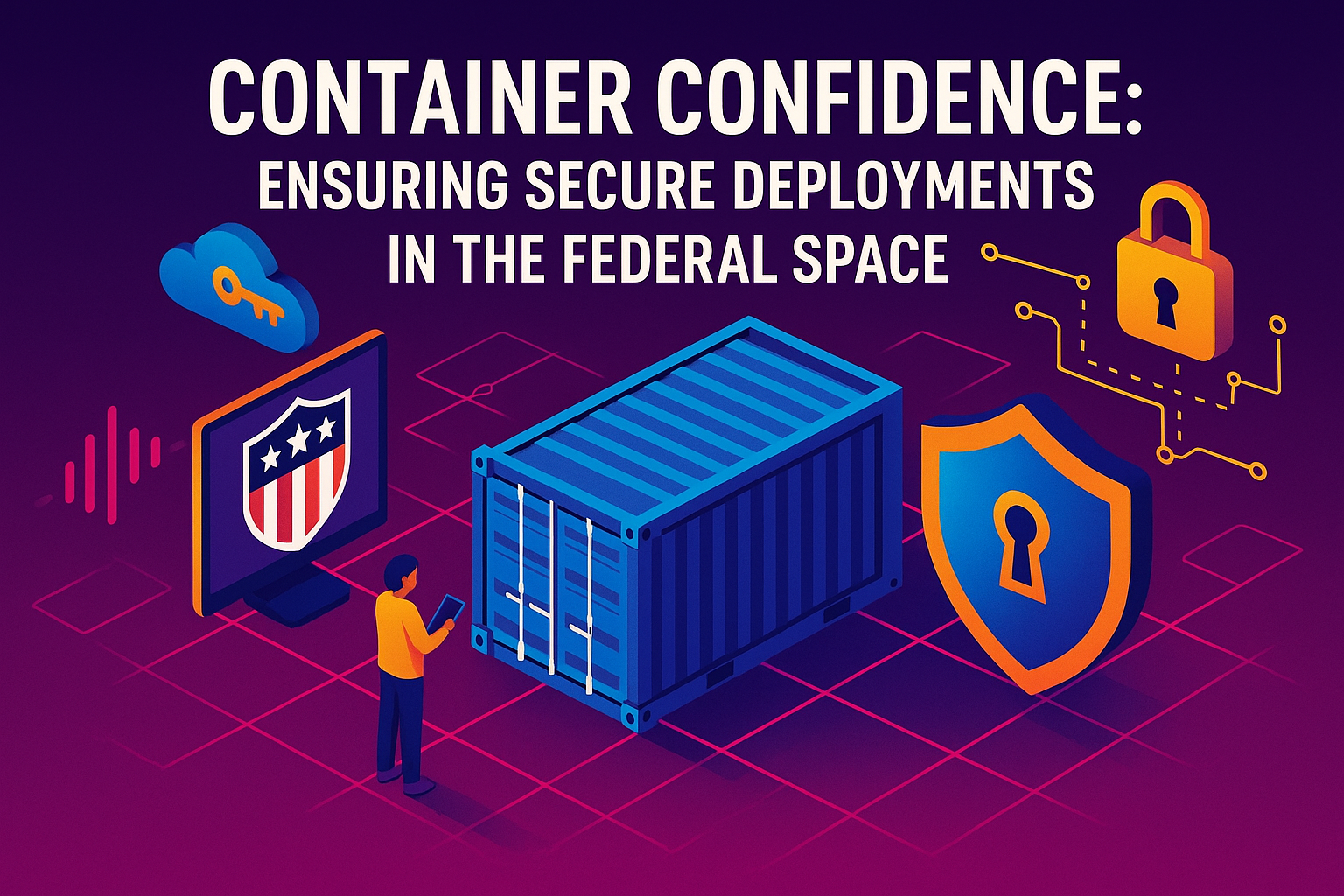Container Confidence: Ensuring Secure Deployments in the Federal Space

In the world of federal IT, securing containers is like trying to childproof a house while the kids are simultaneously growing taller, learning lockpicking, and inviting friends over. Just when you think you've secured everything, someone finds a new way in. But fear not! This guide will walk you through building container confidence in federal spaces, using open-source tools and a layered approach that would make an onion jealous.
The Federal Container Landscape: Not Your Average Deployment
Federal agencies have been adopting containers at an impressive rate, and for good reason. Containers offer consistency, portability, and efficiency that traditional deployment methods simply can't match. According to research, over 90 percent of companies are now using containers, with 84 percent using or evaluating Kubernetes. Federal agencies are no exception to this trend.
But federal environments aren't just any environments. They come with strict compliance requirements, security standards that make ordinary corporate policies look like suggestions, and consequences for failures that extend well beyond a stern email from the CEO. FedRAMP compliance, NIST guidelines, and various other regulatory requirements create a complex web of security considerations that must be addressed.
As one security engineer at a federal agency told me, "Deploying a container in our environment used to feel like trying to get a permission slip signed by every teacher in school, plus the principal, the superintendent, and somehow also requiring approval from the school mascot."
So how do we build container confidence in such demanding environments? By implementing a comprehensive, layered security approach using powerful open-source tools.
Layer 1: Build-Time Security (Or: How I Learned to Stop Worrying and Love the Scanner)
The container security journey begins long before a container is deployed. It starts at the very moment a developer pulls a base image to build upon. This is where our first layer of defense comes in: vulnerability scanning.
Trivy: Your Container's First Security Checkpoint
Trivy has emerged as one of the most popular open-source container scanning tools due to its speed, comprehensive vulnerability database, and ease of use. Think of Trivy as the diligent security guard at the entrance who checks everyone's ID with remarkable efficiency.
Trivy detects vulnerabilities from a wide array of operating systems and programming languages, across different versions, and vulnerability sources. It can also scan infrastructure as code (IaC) configurations, finding misconfigurations in Terraform, CloudFormation, Docker, Kubernetes, and other files right alongside vulnerabilities.
What makes Trivy particularly suited for federal environments is its ease of deployment—it's a single binary with no dependencies, supports air-gapped environments, and can be easily integrated into CI/CD pipelines.
Grype: Another Strong Contender in the Scanning Arena
While Trivy has gained significant popularity, Grype is another excellent open-source vulnerability scanner worth considering. Developed by Anchore, Grype allows you to scan local images directly on your machine, giving you full control over your security checks without relying on external services.
As noted in research, "Unlike cloud-based scanners, Grype allows you to scan local images directly on your machine, giving you full control over your security checks without relying on external services". Its local scanning capability eliminates network delays and dependencies on external APIs, making vulnerability detection faster and keeping sensitive code and configurations secure.
Layer 2: Registry Security (Or: Keeping Your Images as Safe as Fort Knox)
Once your container images pass the scanning stage, they need a secure place to live until deployment. Enter container registries, the secure vaults of the container world.
Harbor: The Fort Knox of Container Registries
Harbor is an open-source registry specifically designed for storing and securing container images in cloud-native environments. It's like having a bank vault with advanced security features, a detailed inventory system, and guards who check every deposit and withdrawal.
Harbor provides crucial security features such as:
- Vulnerability scanning by integrating tools like Trivy
- Image signing and verification to ensure authenticity
- Role-based access control to restrict who can pull and push images
- Replication capabilities for high availability and disaster recovery
Since Harbor is open-source and self-hosted, it gives federal agencies full control over their container images without relying on external services that might not meet their strict compliance requirements.
One federal DevOps engineer shared, "Before implementing Harbor, our container images were like tourists in a foreign country—constantly lost, often unsafe, and without proper documentation. Now they're more like diplomats with full security details."
Layer 3: Admission Control (Or: The Bouncer at the Kubernetes Club)
With secure images stored in a protected registry, the next challenge is ensuring that only compliant containers are allowed to run in your environment. This is where admission control comes into play.
Kubernetes Admission Controllers: The Discerning Bouncers
Kubernetes admission controllers act as bouncers at the door of your cluster, checking each request against your security policies before allowing deployment. They can verify that images come from approved registries, enforce security context constraints, and ensure compliance with your organization's standards.
For federal agencies using GitLab, the integration of container scanning into CI/CD pipelines adds another layer of protection. GitLab can be configured to scan container images and fail pipelines if vulnerabilities are detected, ensuring that insecure containers never make it to production.
One particularly useful feature is vulnerability allowlisting, which lets you specify certain vulnerabilities that should be ignored—useful for handling false positives or vulnerabilities that aren't applicable to your environment.
A security architect at a federal agency quipped, "Our admission controllers are so strict, even my coffee mug needed three forms of ID to get into the office this morning."
Layer 4: Runtime Protection (Or: Watching the Containers While They Work)
Even with all the previous security layers in place, runtime security remains crucial. After all, vulnerabilities can be discovered after deployment, and containers might behave unexpectedly during operation.
NeuVector (now SUSE Security): The Runtime Guardian
NeuVector, now known as SUSE Security, provides comprehensive runtime security for container environments. It acts as a vigilant guardian, monitoring container behavior and network traffic to detect and prevent attacks.
SUSE Security offers several critical runtime protection features:
- Zero Trust container security that monitors and blocks suspicious activities
- Layer 7 network security between containers
- Host security that detects privilege escalations and monitors file activities
- Automatic threat detection for common attacks like DDoS and DNS attacks
This runtime protection complements the earlier security layers, creating a comprehensive security posture that addresses threats at every stage of the container lifecycle.
A container security specialist from a government contractor observed, "Runtime security is like having a security camera inside your house. You've locked the doors and windows, but you still want to know if someone made it inside anyway."
Container runtime security represents the proactive measures and controls used to protect containerized applications during their runtime phase. Since containers share the host's kernel, if a malicious actor breaks out of one container, they may gain access to other containers or the host, resulting in a significant security incident. Thus, it's paramount to have robust security measures in place during runtime.
Compliance Considerations (Or: Making the Auditors Happy)
For federal agencies, compliance isn't optional—it's mandatory. Fortunately, the layered security approach we've discussed aligns well with federal requirements.
FedRAMP and Container Security
The Federal Risk and Authorization Management Program (FedRAMP) doesn't provide container-specific controls, but containers are part of the infrastructure and must comply with broader security requirements.
FedRAMP leverages NIST 800-53 controls to assess container environments and workloads, while also requiring container hardening based on guidelines such as those in NIST SP 800-190.
The key compliance areas for container security include:
- Access control: Ensuring proper authentication and authorization
- Configuration management: Managing container configurations securely
- System and information integrity: Maintaining container integrity throughout its lifecycle
According to FedRAMP's checklist for containers, it's essential to accurately capture and document your organization's container image footprint. This fundamental step helps assess the scope of security requirements and ensures complete coverage of all containerized assets.
NIST SP 800-190: The Container Security Bible
NIST Special Publication 800-190, or the Application Container Security Guide, provides comprehensive guidance on securing containerized applications. Published in 2017, it outlines threats, vulnerabilities, and countermeasures specific to container environments.
The guide covers various aspects of container security, including securing the build pipeline, implementing runtime security controls, and managing container orchestration security. By following these guidelines and using the tools we've discussed, federal agencies can build container confidence while maintaining compliance.
Putting It All Together: The Secure Container Pipeline
Now that we've explored each layer individually, let's see how they work together to create a comprehensive security posture for containerized applications in federal environments.
A Day in the Life of a Secure Container
- A developer commits code to a repository, triggering a GitLab CI/CD pipeline
- The pipeline builds a container image from the code
- Trivy or Grype scans the image for vulnerabilities, flagging any issues
- Once approved, the image is signed and stored in Harbor
- When deployment is requested, admission controllers verify the image's signature and compliance
- After deployment, NeuVector/SUSE Security monitors the container during runtime
- Regular rescans are performed to check for newly discovered vulnerabilities
This integrated approach ensures security at every stage of the container lifecycle, from development to production.
Best Practices for Federal Container Security
Based on our research, here are some key best practices for securing containerized applications in federal environments:
- Ensure secure container images by removing unnecessary packages, disabling unnecessary services, and minimizing the attack surface
- Implement role-based access control (RBAC) to restrict who can deploy and manage containers
- Apply image hardening techniques and use image signing to verify authenticity
- Regularly update and patch container images to address newly discovered vulnerabilities
- Implement network segmentation to control container-to-container and container-to-external communications
- Use multi-factor authentication and enforce strong access controls
- Encrypt data both in transit and at rest to protect sensitive information
- Regularly audit your container environment to identify potential security issues
One security officer remarked, "These practices are like flossing—everyone knows they should do it, few people do it enough, but those who do consistently have much better outcomes in the long run."
Looking Ahead: The Future of Container Security
As container adoption continues to grow in federal agencies, the security landscape will undoubtedly evolve. New threats will emerge, new tools will be developed, and best practices will be refined.
The good news is that the open-source community continues to innovate in the container security space. Tools like Trivy, Grype, Harbor, and NeuVector are constantly improving, adding new features and enhancing their security capabilities.
Federal agencies that adopt a layered, comprehensive approach to container security—leveraging these powerful open-source tools—will be well-positioned to deploy containerized applications with confidence, even as the threat landscape changes.
Remember, container security isn't a destination; it's a journey. As one federal CIO put it, "We used to think security was a product you could buy. Now we know it's a process you have to live."
So begin your container confidence journey today. Your applications, your users, and yes, even your auditors will thank you.
And if all else fails, you can always tell the security auditors that your containers are so well-secured, even you can't access them. That's a joke, of course, but sometimes in the world of federal IT security, it feels surprisingly close to reality.

